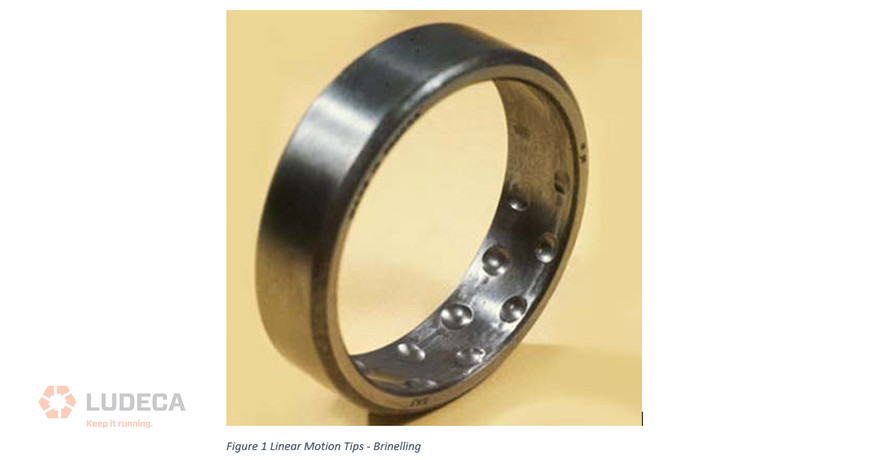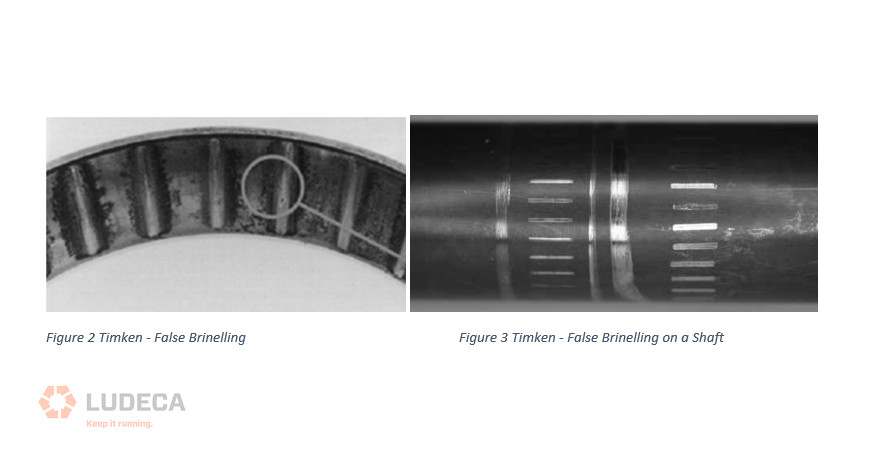What is the difference between Brinelling and False Brinelling? What causes Brinelling and False Brinelling?
Brinelling
Brinelling is named after the Brinell scale of hardness. In the Brinell hardness test, a small ball is pressed into the surface of a material using a specific amount of force. The size of the indentation that occurs in the material is a measure of its hardness. Brinelling is an indentation in the surface of a material; a permanent plastic deformation that occurs when the yield strength of the material has been exceeded.

Brinelling can occur in rolling element bearings when large static loads cause the balls or rollers to create indentations on the race; usually spaced the same distance apart as the balls or rollers. It can also be caused by a single impact or a repeated impacting. The main point is that the forces of the balls against the race exceed the yield strength of the material and result in a permanent dent. These excessive forces may occur during transportation, in storage, or during the bearing installation process. Special care must be taken when pressing or clamping bearings to avoid causing damage.
False Brinelling
False Brinelling in a stationary bearing creates a similar pattern of marks on the race separated by the distance between the balls or rollers. This wear pattern is called “fretting.” False Brinelling occurs when vibration pushes the oil out of the contact surface between the balls or rollers and the race. The loads in this case are not enough to cause permanent damage or indentations in the race, but the polishing of the race surface causes it to look like Brinelling – hence the name “false brinelling.” Because the races are polished by surface-to-surface contact in the absence of oil but are not actually damaged, the wear pattern will disappear after a short break in period.

False Brinelling in a stationary bearing often occurs during transportation of bearings or when they are in storage if they are subjected to vibration from trains or forklifts passing by or other sources of vibration. It is also common in standby machines if they are not isolated from the vibration coming from other machines running nearby.
It’s also possible for false brinelling or fretting to occur in rotating bearings if the rotational speed causes the balls or rollers to make contact with only specific parts of the races over and over again. This causes a similar wear pattern however in this case the distance between the wear marks will not match the distance between the balls or rollers.
Take Care of Your Bearings!
The proactive approach to bearing care includes being careful about how bearings are shipped, stored, and installed. Brinelling and False Brinelling can be avoided by using correct packaging, rotating stationary shafts, and storing bearings in cabinets that are mounted on vibration isolators and that have damping material on the shelves.
WANT TO LEARN MORE?
Alan Friedman dba Zenco offers machinery vibration analysis courses and certification in accordance with ISO 18436-2. You can see the live course schedule here: www.ZencoVibrations.com/events You can connect with him on Linkedin. In addition to public classroom training and public virtual courses, Alan is also available for private courses virtually or on-site in addition to informal training and mentoring. Category I and II vibration are also available in Spanish.
Alan, aka the Vibe Guru, has over 30 years of vibration analysis experience, He has trained thousands of students around the world up to Category IV. One of the things that makes Alan a great teacher is his ability to teach people where they are at. Whether you are a math-challenged millwright, an engineer, or a PhD, Alan will challenge you without overwhelming you. If you are interested in condition monitoring you can also check out his book: Audit It. Improve It! Getting the Most from your Vibration Monitoring Program or hire him for an on-site program audit.
Did you know that Alan Friedman left Mobius and is now providing his own courses?
Filed under:
Vibration Analysis by Ana Maria Delgado, CRL
